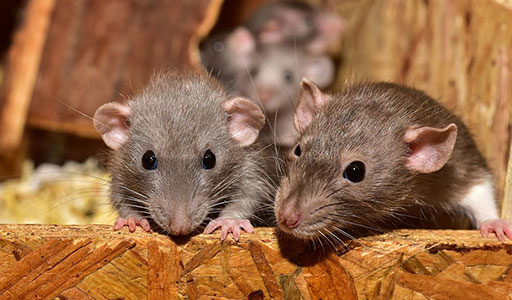Rat Pest Control
Do you need to get rid of rats? We can help!

Rat Removal Strategies
Rat Problem

Signs a Rat is on Your Property
In your home, there is no animal quite as terrifying to come across as a rat. These small rodents are quick to act, potentially destroying parts of your home and yard with their chewing and defecation. Rats are known to carry bacteria, diseases, and insects that can harm both pets and humans. Whether you live in an overpopulated city, rural countryside, or suburbia, you may come across a rat in your home or yard.

Dangers of Rat Infestation
Rats destroy property with their constant gnawing, as they chew through wooden structures and wires. This behavior can lead to electrical shorts and even devastating building fires. Often ridden with disease, rats spread pathogens through their feces and urine, as well as through bites and scratches. They also burrow, which frequently results in damaged structures and landscapes. Gardeners report significant losses at the hands of the rodents, as rats eat vegetables, nuts, and fruits.
Humane Rat Removal & Control Strategies

Entry into property
The rodents frequently seek refuge inside warm homes, which provide shelter from potential predators and access to human foods. Both attics and garages are ideal nesting locations inside, while sheds and barns on private properties also provide adequate shelter for the pests.

Trapping & Removal
As they reproduce quickly and cause so much damage, rats create infestations that should be dealt with immediately. Contacting pest control specialists is highly advisable. Historically, professional removal is the only way to ensure complete rat eradication. Trutech is always ready to assist with rat trapping and removal needs.

Prevention & Exclusion
Maintaining high standards of sanitation helps reduce the possibility of rat infestation. Trash should be disposed of in sealed bins, floors and counters should be cleared of crumbs, and foods should be stored in rodent-proof containers. Finally, attics and yards should be regularly checked for rat activity. Points of entry larger than one-fourth of an inch in diameter must be sealed with wire, caulk, or other suitable materials.
Rats in House
Destructive and troublesome, rats traditionally live in close proximity to humans. This puts rats in the prime position to invade homes and other buildings, where ample availability of food and nesting sites provides the rodents with everything they need to survive. The pests gain entry to homes in a variety of ways. They can fit through any opening larger than 1/2 an inch in diameter, which means that small holes, gaps in doorways, and wall vents often serve as common entry points for the agile rodents. Rats are also proficient swimmers capable of traveling through sewer lines and entering buildings by emerging from toilets and open drains.

SIGNS OF RATS IN THE HOME
When rats enter homes, they prefer to stay out of sight in undisturbed areas. Identifying a rat infestation, however, is easy, especially as the rodents increase in number. Rats move around a lot and individuals should listen to the sounds of scurrying in attics, false ceilings, and wall voids. These noises intensify at nighttime, as rats are nocturnal and become most active after dusk. Additionally, homeowners should look for rat droppings around sources of food, like pantries, smudge marks on walls left by the greasy, oily fur of rats, and gnawing damage. Finally, residents may spot adult rats in sheltered locations such as storage boxes, seldom-used drawers, and stacks of firewood.
RAT DANGERS IN THE HOUSE
Rats in the house can create serious problems for both people and property. Their droppings have been known to contain disease-causing pathogens, while their constant gnawing causes property damage and can even start electrical fires. Rats also get into and contaminate food intended for humans and pets. Due to the health risks created by rat infestations, professional pest control is often the best way to achieve complete rat removal safely and effectively.
COMMON PLACES TO FIND RATS IN YOUR HOME
- Attic
- Walls
- Under Porches
- Yards
- Trees
DO YOU HEAR RATS IN THE ATTIC?
One of the main reasons rats invade homes is for shelter from cold weather. As attics are some of the warmest spaces in houses, it’s no wonder rodents, like Norway and roof rats, enjoy constructing nests in these secluded top stories.
The pests gain entry through vents, gaps in roof eaves, and through holes in building exteriors. Roof rats are especially talented climbers and easily use tall trees and wires running to and from roofs to gain access.

SIGNS OF RATS IN THE ATTIC
Homeowners may be alerted to the presence of rats in the attic by sounds, sights, and smells. Usually the most apparent signs of infestation are the scratching and scurrying sounds these rodents make. As rats are nocturnal, they are noisiest when individuals are settling in for a night of rest. Additionally, home residents may notice visual cues such as rat droppings, teeth marks in food containers, and even tracks. Finally, the musky smell of rat presence and malodorous collections of droppings and urine are sure indications of rat infestations in the attic.
NOISES & SMELLS
Homeowners should also listen for rustling, clawing, and squeaking sounds coming from inside wall cavities. These sounds intensify in the evenings when the rodents are preparing for a night of activity. Another sure sign of a rat infestation is the pungent smell of urine concentrated within the walls where the pests nest.
RAT OUTSIDE YOUR HOUSE
Rats are consistently searching for nesting locations that protect them from predators and the elements and offer steady supplies of food and water.
Since they routinely travel up to 300 feet for food, rats outside your house still pose a risk. Rats in the yard, under your deck, or in trees will eventually venture into nearby homes in search of garbage, animal feed, and foodstuffs.
RATS UNDERNEATH THE DECK
Decks with their overhead cover and seclusion make the perfect nesting sites. Since rats can fit through small openings, they easily worm their way underneath decks where they enjoy relative safety and comfort.
Furthermore, rats under decks easily find entrance into homes.

SIGNS OF A RACCOON UNDER THE DECK
Property owners may be alerted to the presence of raccoons under decks through various sights, sounds, and smells. The pests designate an area to eliminate waste, known as raccoon latrines, that smell abhorrently and contribute to the spread of disease. Finding a latrine in the yard is a sure sign of infestation. Additionally, raccoons make scratching noises and vocalizations throughout the night that may keep residents awake. The presence of tracks around private properties also points to the existence of raccoons under decks. Finally, individuals can test for the presence of the pests by situating a few sticks just outside deck openings. Placing them so that no animal could move through without disturbing the sticks allows for safe raccoon detection.
DANGERS & REMOVAL
Amature trapping and baiting efforts can actually make rats wary and drive them inside homes to escape threats.

EVIDENCE OF RAT INFESTATIONS
Both Norway rats and roof rats thrive throughout the U.S. The Norway species tends to be solitary, but an infestation can still consist of up to 40 rodents in a single home. In contrast, roof rats are more social and will live in colonies of over 100 rodents. Signs of rats include visual, sound, and scent clues.
SIGNS OF RATS IN THE HOUSE OR ATTIC
There are a number of ways to discover an infestation within a home, such as noticing:
- Droppings – Fresh rat poop is black, shiny, and about the size of a raisin.
- Noises – Homeowners may hear scratching, squeaking, and gnawing sounds coming from attics, crawl spaces, or walls.
- Tracks— Four-toed front feet and five-toed hind feet paw prints found in mud, dust, snow.
- Rat hair – Shed fur may snag on rough wood or inside pantries and cabinets.
- Smears and smudges – Oil from rat fur transfers to surfaces as the pests move.
- Holes – Rats chew ragged openings in food packages and containers.
- Odor – Rodents have a musky scent that gets stronger as populations grow.
RAT POOP
Although different kinds of rodent infestations require different means of treatment, many homeowners are unable to tell one scaly-tailed, scurrying pest from another. One of the easiest methods of differentiating between a rat problem and a mouse infestation is by looking at the pests’ feces. Fresh rat droppings look like raisins, with an elongated, spindle shape and dark black or brown coloring. After a couple of days, they harden and fade to dirty white. Mouse droppings have similar qualities, but are smaller, resembling dark grains of rice.
RAT VS MOUSE POOP
As a rule, rat poop:
- Measures about 1/3 of an inch in length
- Appears similar in size to a raisin
- Has one-pointed or tapered end
On the other hand, mouse feces:
- Never exceed 1/4 of an inch long
- Look like grains of rice
- Have pointed ends

DANGERS OF RAT FECES
Norway rats and roof rats are the most prevalent species in the U.S. Similar in appearance, Norway rat droppings and roof rat droppings are known to carry disease-causing pathogens. Among the illnesses, these rodents can give to humans are the plague, leptospirosis, salmonellosis, typhus, tularemia, meningitis, and Hantavirus. The most common method of transmission is inhalation. When dried rat droppings are disturbed, these viruses often become airborne. Some, including Hantavirus, remain in the air for several days afterward. Rat diseases can also be spread through contaminated food, as the pests tend to eat and defecate in pantry items.
IDENTIFYING RAT TRACKS
The easiest places to notice rat tracks are in snow, mud, and dust, so little-used basements and muddy areas around home foundations are good places to start. Searching for tracks may also help in the identification of how rats are getting into homes. Additionally, these pests establish regular foraging trails to move between their nests and food sources, so they often leave behind well-worn paths.
Rat tracks vary from about one-half to one inch in length and width depending on the individual pests’ age, size, and sex. Like most rodents, rats have four-toed front feet and five-toed hind feet. Unlike the tightly aligned toes on their back paws, the toes on their front paws are widely spaced in a circular pattern.
Rat footprints often have a smudged appearance, as only the front half of their paws typically leaves a clear imprint, and these are often obscured by their hind feet as the pests run. In addition to tracks, evidence of rats includes droppings, gnawed wood and plastic items, and greasy oil marks on walls.

PROBLEMS AND PREVENTION
During the springs and summer, rats create trails between outdoor burrows. However, as the winter sets in, many begin to invade homes. Warm spaces are favored places to overwinter, so homeowners may discover rat tracks in snow leading to exterior walls. Since paw prints left by rats, mice, squirrels, and a variety of other rodents can look very similar, utilize the expertise of the professionals at Trutech to help identify rat tracks and effectively deal with infestations.
SIGNS OF RATS IN THE YARD
Finding evidence of rats near lawns and gardens often means the pests have nests in outbuildings or under porches and decks. Signs of rats outdoors include:
- Runways – Rats will travel repeatedly to food sources and leave worn trails in grass or mud.
- Tracks – Footprints left behind in dust or moist earth can help residents find rodent nests.
- Burrows – Holes about four inches wide leading into narrow tunnels are a specific sign of Norway rats.
Homeowners who find signs of rats in the home, yard, or attic should contact the pest control experts at Trutech for efficient rodent exclusion and removal.
Rats reproduce quickly, making it difficult to prevent infestations once they’ve settled in homes or yards.
While simple prevention methods may work in the short term, rats travel in large numbers and are quick to overcome obstacles. The pests grow used to audible scare tactics quickly, although loud noises may drive them away temporarily. Rats also become resistant to repellants and toxins.
Traps are the most effective method of dealing with rats. However, knowing how to properly select, place, and bait a trap can mean the difference between successful removal and continued problems.
RAT DAMAGE IN ATTICS
Residents of homes are put at risk when there are rats in the attic. As the rodents must constantly gnaw to keep the length of their teeth manageable, they can damage the structural integrity of buildings by chewing through wooden support beams. Rats also target electrical wires and heighten the possibility of fire.
I know I have rats in my attic and have caught a couple. I would like to get a proposal for sealing off the exterior of the house as well as attic cleanup. Do you completely remove all insulation, then clean and replace? I now also have a mothball problem. I threw them out in the attic to run off the critters, which of course didn’t work, but my house now reeks of them. My preference would be to have all the insulation removed and replaced. – Fort Worth, TX
Being as there is already a known history of rats in the home, we would start with a full inspection to determine necessary repairs, and the extent of the issue. The next, and most important step of the process is to begin an ongoing service with an aggressive initial trapping session. Once the initial rat population has been decreased or eliminated; we would then put preventive measures into place to maintain control of the population. To address the issue of replacing the insulation we can remove contaminated areas and replace insulation in smaller areas. We also offer services to rejuvenate old flattened, damaged insulation to increase the r-value. If a full removal and replacement is needed, we can suggest one of our sister companies to aide in the process.
Adrienne

ARE THERE RATS IN YOUR WALLS?
Rats are particularly fond of settling in the dark, secluded areas between walls once they’re inside homes as these spaces have lots of insulation to tear apart and use for bedding as well as wooden boards to gnaw on. At night, these pests venture out into the body of houses to gather food from pantries, countertops, and garbage cans before retreating back to their nests in the walls.
SIGNS OF RATS UNDER THE DECK
Since rats are primarily active at night, infestations usually go undetected for some time. However, knowing what rat signs to look for allows property owners to notice the presence of rats
under decks sooner. Telltale signs of rat infestations include scratching and squeaking noises, the presence and smell of urine and excrement, and remnants of nesting materials like ripped up insulation.
A clever way to detect the presence of rats under decks is to place newspaper over the openings. After a few days, if the paper is ripped or gone, property owners should assume they’re dealing with an infestation.
GET RID OF RATS FROM YOUR BACKYARD
Backyards make attractive nesting prospects for rats because they offer plentiful access to both food and shelter. The pests are opportunistic feeders and will not hesitate to pilfer food from gardens, outdoor trash cans, and pet feed that’s been left out.
Furthermore, as the pests are agile runners, jumpers, climbers, and swimmers, they navigate residential lawns with ease. Popular backyard nesting sites include brush piles, overgrown shrubberies,
abandoned squirrel nests in trees, unused sheds, and garbage piles.
SIGNS OF RATS IN THE BACKYARD
Look for rats running across the ground, cables, fences, and tree branches near dusk. Property owners may also find small cylindrical fecal pellets where rats nest and feed, in places like trash cans and garbage piles. Rats regularly take the same paths to and from their nests and feeding areas, which creates visible runways of trampled vegetation. Finally, their tiny feet may also leave tracks in dirt or mud.
I would like to have a technician come to my home to give me a proposal for controlling rats that have come into my yard. They are not in the house yet, but I wish to discuss possible preventive measures.
-Grayson, GA
:
We would start with scheduling a full inspection of the home and property. Just because you haven’t seen or heard rats, that doesn’t necessarily mean they haven’t made entry into the home, so an attic assessment is required, along with the exterior inspection. If rat activity is found, interior trapping would be required, along with exclusion of any exterior entry points on the home. If there isn’t any current rat activity then exclusion is still recommended to keep the attic clear.
As far as controlling the rats coming into the yard, an exterior rodenticide treatment would be required using rodent bait stations placed around the home and maintained on a monthly basis.

RATS IN TREES NEAR HOUSE
As agile climbers, rats are easily able to infest trees. The pests are opportunistic feeders that regularly eat insects and fruits, which makes trees suitable nesting sites as they offer these food sources in abundance. Capable of leaping both horizontally and vertically, rats maneuver to the tops of trees by climbing walls and power lines. Furthermore, the pests utilize the high elevation afforded to them by vegetation to gain access to upper levels of homes and buildings. Entrance into attic and ceiling spaces encourage rats to build nests in trees.
WHAT SOUNDS DO RATS MAKE?
Oftentimes, rat sounds are the first indicators of rodent problems within the home. When indoors, these pests can be heard gnawing on floor joists, siding, and electrical wiring to grind down their front teeth. They also scamper within walls, commonly leading homeowners to misidentify them as larger pests. However, when the scurrying is paired with incessant squeaking, residents should assume the sounds are coming from rodents. Other rat noises include hissing and shrieking to ward off enemies.

PRESENCE OF RATS
Rat sounds aren’t the only indication of an infestation. The pests also contaminate nearly every surface they touch with trace amounts of fecal matter. Their search for food ranges from pantry items to pet food, garbage, and other animals’ droppings. Therefore, finding chewed open packages can point to thriving rodent populations. The pests typically build their nests in wall voids and crawl spaces. Since dogs and cats are often attracted to areas of the home where rat noises are being produced, pets’ preoccupation with certain rooms sometimes leads homeowners to discover infestations.
RAT SOUNDS COMING FROM THE ATTIC
Homeowners that hear scratching noises in the attic at night may be dealing with rats. These nocturnal pests typically enter homes through basements, subfloors, and hollow walls, though some species, such as roof rats, are particularly common in the attic. Noises at night, such as gnawing, clawing, scratching, or squeaking, are usually the result of rats communicating with each other.
Depending on their mood, these vocal pests make a variety of different sounds. Teeth chattering or clacking may indicate feelings of anxiety or contentment, while fighting rats can make a loud shrieking, hissing, or squeaking noise. In the attic, rodents may also keep homeowners up at night with sounds caused by their movement. As rats travel between their nests and food sources in kitchens, pantries, or bathrooms, residents may hear rustling or scratching overhead.

ARE THESE NOISES RATS IN THE WALLS?
Known to infest homes during severe weather or when food is scarce, rats often utilize walls and voids within buildings for travel and nesting. These agile pests do the majority of their scavenging from dusk to dawn. Homeowners may discover infestations when they hear rat noises in the wall at night or in the early morning. While people can sometimes pick up the sound of rats squeaking in walls, it is more common to notice louder, more repetitive activities. These typically include rustling or scratching noises in the wall when the pests run, as well as thumping sounds that occur when they bump surfaces. In addition, rats are notorious for chewing electrical wires and other dangerous household items. A gnawing sound in walls, when loud enough to detect, frequently signifies rat infestation. This can be cause for concern, as damaged wires are a serious fire hazard.
Do Rat Traps Work?
This control measure is surprisingly effective. Since the pests are drawn to strange objects in their surroundings, they’re extremely susceptible to traps.
Unfortunately, trapping is not a long-term solution to pack rat problems. Homeowners are better off targeting factors that attract rodents in the first place such as poorly stored food or breaches leading into homes.

Other Issues with Rat Traps
Though rat traps have a higher rate of success than other control methods, this doesn’t mean it’s the best way to get rid of infestations. These animals often host a number of disease-carrying parasites in their fur, which means getting too close can be a health risk. Also, after using a rat trap, homeowners are left to dispose of the animal in addition to dealing with the disgusting nest the pest leaves behind.
IMPORTANCE OF EFFECTIVE RAT CONTROL
It is vital to control rat populations because these rodents are highly fertile. One female is able to give birth to two babies per month. After two months, those offspring have developed enough to start having young of their own.
Instead of inviting the dangers of DIY trapping, contact the professionals at Trutech for safe and effective control of rats.
THE PROBLEM WITH HOME RAT REPELLENTS
There is more than one DIY rat repellent, though none are completely effective.
Popular repellents include:
- Putting out mothballs
- Sprinkling cayenne pepper in gardens
- Enclosing plants with hardware cloth
There are several issues with these approaches. Mothballs only last a short time and can be toxic to pets and small children. The other two rat deterrents may show some results outdoors, but don’t address indoor pests.
TYPES OF RAT TRAPS
Homeowners looking to control infestations are usually offered standard rodent traps such as snap, cage, and burrow entrance traps, as well as glue boards.
Frequently Asked Questions
Aptly named, rat-bite fever is transmitted through contact with the rodents’ saliva. This, along with Hantavirus, salmonellosis, E. coli poisoning, and leptospirosis, is one of the illnesses people can catch directly from rats. Ticks, fleas, and mites that live in the pests’ fur often ferry rat diseases to humans indirectly.
In addition to the plague, these parasites may carry Lyme disease and Rocky Mountain spotted fever. The pests’ droppings, dander, and fur can also trigger allergic reactions.
There is more than one DIY rat repellent, though none are completely effective.
Popular repellents include:
- Putting out mothballs
- Sprinkling cayenne pepper in gardens
- Enclosing plants with hardware cloth
There are several issues with these approaches. Mothballs only last a short time and can be toxic to pets and small children. The other two rat deterrents may show some results outdoors, but don’t address indoor pests.
Homeowners looking to control infestations are usually offered standard rodent traps such as snap, cage, and burrow entrance traps, as well as glue boards.
Do Rat Traps Work?
This control measure is surprisingly effective. Since the pests are drawn to strange objects in their surroundings, they’re extremely susceptible to traps.
Unfortunately, trapping is not a long-term solution to pack rat problems. Homeowners are better off targeting factors that attract rodents in the first place such as poorly stored food or breaches leading into homes.
Other Issues with Rat Traps
Though rat traps have a higher rate of success than other control methods, this doesn’t mean it’s the best way to get rid of infestations. These animals often host a number of disease-carrying parasites in their fur, which means getting too close can be a health risk.
Also, after
Homeowners may be alerted to the presence of rats in the attic by sounds, sights, and smells. Usually the most apparent signs of infestation are the scratching and scurrying sounds these rodents make. As rats are nocturnal, they are noisiest when individuals are settling in for a night of rest. Additionally, home residents may notice visual cues such as rat droppings, teeth marks in food containers, and even tracks. Finally, the musky smell of rat presence and malodorous collections of droppings and urine are sure indications of rat infestations in the attic.
To detect the presence of rats in walls, residents should remain alert for rat droppings around homes, oily smudge marks, and gnawed holes in walls and food containers. Droppings are long, cylindrical pellets typically dark brown in color that can be found wherever rats frequent.
Smudge marks appear as greasy patches on floors and walls as a result of the pests’ dirty fur rubbing up against a surface.
Finally, rats use their large front teeth to chew access holes into walls and gnaw open food containers. These openings are ragged around the edges and may only be as large as half an inch in diameter.


